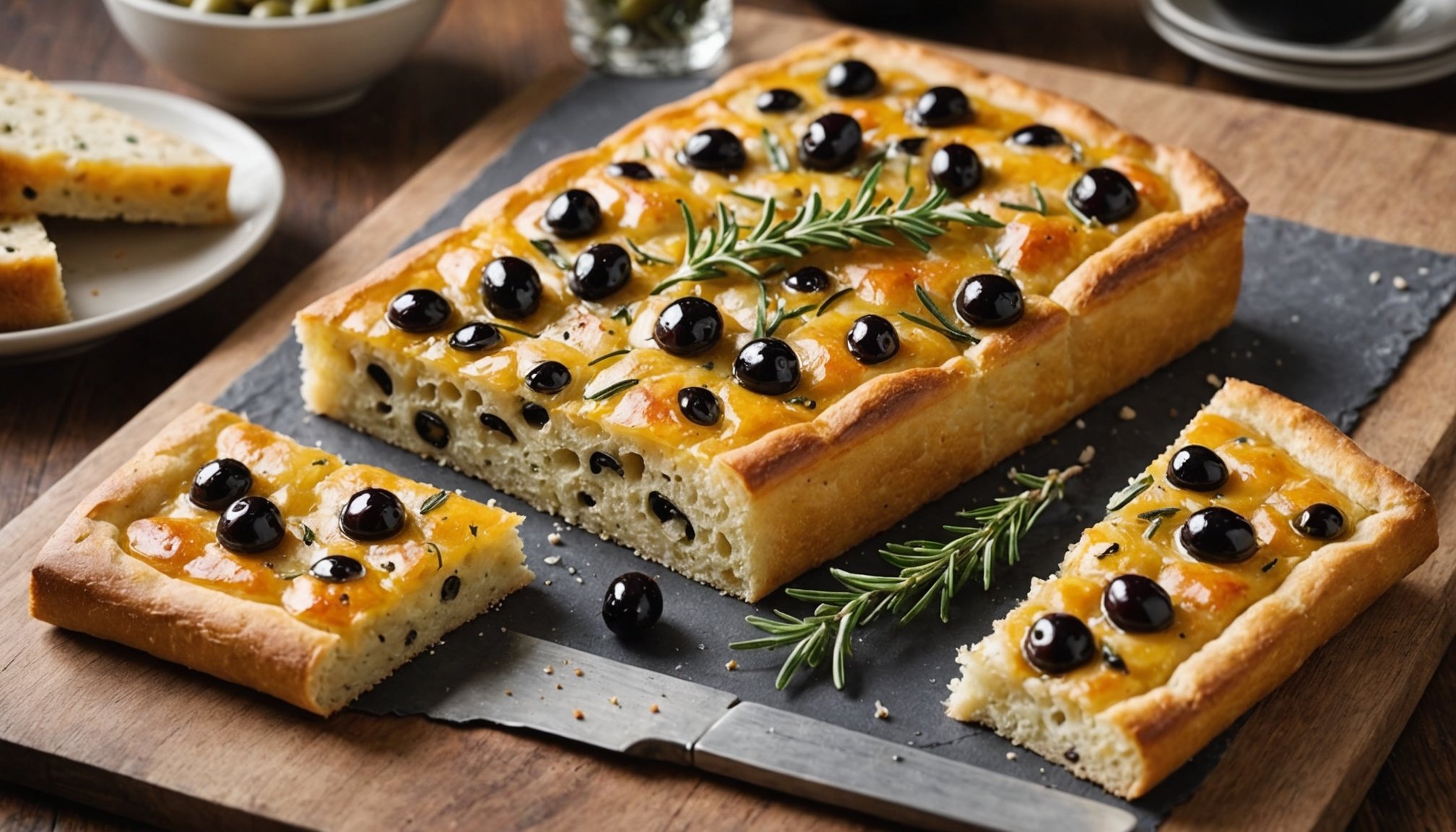Recipe Overview
Prepare to embark on a delightful culinary journey with a gourmet focaccia recipe that combines the rustic charm of olive and rosemary. This Italian bread, noted for its crispy exterior and soft interior, is a must-try for any baking enthusiast. The magic of this recipe lies in the quality ingredients, which play a pivotal role in elevating the flavors and textures.
When it comes to baking focaccia, the importance of quality ingredients cannot be overstated. Opt for extra virgin olive oil to impart a rich, fruity flavour. Fresh rosemary sprigs bring an aromatic earthiness that perfectly complements the olive’s zest. Additionally, using premium flour ensures a light and airy crumb structure, delivering the perfect balance of flavors and textures.
Have you seen this : Mastering the Art of French Macarons: Create Irresistible Raspberry-Filled Delights!
The textural delight offered by this focaccia recipe comes from its combination of a lightly crisped top with an airy, chewy center. The subtle interaction of saltiness from the olive oil, the fragrance of rosemary, and a touch of sea salt creates a flavour profile that is as refined as it is comforting. Indulge in the luxurious experience this baking creation offers, and discover the joy of homemade gourmet focaccia.
Ingredients Required
Making a delectable focaccia begins with a collection of fundamental focaccia ingredients. A typical recipe requires all-purpose flour, water, yeast, salt, and olive oil. These baking essentials form the foundation for the classic Italian bread, each playing a crucial role in achieving the desired texture and flavour. While all-purpose flour is commonly used, some may opt for bread flour for extra chewiness.
Also to discover : Mastering the Art of Gourmet Quiche Lorraine: Achieve a Flawlessly Crispy Crust!
Incorporating different olives or herbs can transform the traditional focaccia into a culinary delight. Variations such as using Kalamata or green olives, and herbs like rosemary or thyme, introduce distinct flavours. Fresh herbs infuse a more vibrant essence compared to dried ingredients, which may offer a concentrated taste but lack the aromatic freshness.
For those considering the use of fresh versus dried elements, it’s important to know: fresh herbs lend a more potent and authentic flavour profile to focaccia compared to dried ones. However, dried herbs can be more convenient and have a longer shelf life. Thus, the choice between fresh and dried often depends on availability and personal preference. The key is balancing flavours to suit your taste when preparing your focaccia ingredients.
Step-by-Step Baking Instructions
Baking focaccia is a delightful culinary adventure. By mastering the right baking methods and cooking techniques, you can create a delicious, airy bread full of flavor.
Preparing the Dough
Begin by mixing flour, water, yeast, and salt to create your dough. Achieving the perfect dough texture is crucial here. Mix until the ingredients are fully combined, resulting in a sticky mixture. A handy tip is to slightly wet your hands when handling the sticky dough, which helps prevent the dough from adhering to your fingers.
First Rise
Patience is essential during the first rise, a step not to be rushed. Allow the dough to rest in a warm place. Typically, this takes about an hour or until the dough has roughly doubled in size. The warmth encourages yeast activity and gluten development, crucial factors for a well-risen focaccia.
Shaping the Focaccia
Once your dough has risen, transfer it to a baking sheet lined with parchment paper. Gently press it into shape. Be careful not to deflate it, as you want to maintain air pockets for fluffiness. Use your fingers to create dimples across the surface, a hallmark of traditional focaccia. Then, allow it to undergo a second brief rise to bolster its texture before baking.
Baking Tips and Techniques
Baking focaccia successfully requires attention to ideal temperatures and times. A common recommendation is to bake at 220°C (428°F) for about 20-25 minutes. This ensures a crispy crust without compromising the airy crumb.
Achieving the Perfect Crust and Crumb
The perfect crust is achieved by combining the correct heat levels with proper hydration. Steam can also play a crucial role. Introduce steam by placing a small pan of water in the oven during the first 10 minutes of baking. This action keeps the dough surface moist, allowing it to expand and form blisters.
Baking Stones vs. Baking Sheets
A baking stone can transform your bread baking techniques by ensuring even distribution of heat. It absorbs and radiates heat consistently, promoting a uniform crust. Preheat your stone adequately before placing the focaccia onto it. However, if you don’t have a baking stone, a heavy-duty baking sheet is a reliable alternative. While it might not retain heat as consistently, you can still achieve a respectable crust by preheating the sheet and keeping it at the centre of the oven. Both methods are excellent for incorporating baking techniques that elevate your focaccia to professional standards.
Serving Suggestions
When it comes to focaccia serving ideas, there are endless possibilities to enhance your dining experience. Olive and rosemary focaccia pairs beautifully with a wide range of dishes, making it a versatile addition to any menu.
For an elevated flavour experience, consider pairing it with fresh salads. A simple green salad with a light vinaigrette complements the rich, savoury notes of the focaccia. Alternatively, you can serve it alongside a hearty soup or stew, where the bread can be used to soak up the delicious flavours.
For gatherings, get creative with your focaccia serving ideas to impress your guests. Slice the bread into small squares and top each with a dollop of cream cheese and a slice of smoked salmon for a delectable canapé. Or, present a focaccia board with an array of antipasti, featuring olives, cured meats, and cheese selections.
Presentation is key to leaving a lasting impression. Arrange the focaccia on a large wooden board, and garnish with sprigs of rosemary or a drizzle of olive oil for a touch of elegance. Incorporating these pairing suggestions and presentation tips will ensure your focaccia truly shines on any occasion.
Cultural Significance and History
Focaccia holds a cherished place in Italian cuisine, believed to have originated from the ancient Etruscans or Greeks who once inhabited the Italian peninsula. This flat, oven-baked bread is a staple in many Italian households, often considered an ancestor of modern pizzas.
Regional variations of focaccia can be found throughout Italy, with each region adding its unique twist to the recipe. In Liguria, focaccia is typically enriched with olive oil and sometimes sprinkled with rosemary, creating the classic “focaccia Genovese.” Meanwhile, in the region of Puglia, it is known to incorporate potatoes into the dough, adding a different texture and flavour.
Focaccia has interesting historical anecdotes that link it to celebrations and rituals. In ancient times, it was used as an offering to the gods and was prominently featured in religious ceremonies. Over centuries, this bread has evolved, influenced by cultural exchanges and culinary experimentation, retaining its status as an enduring symbol of community and sharing.
These cultural recipes illustrate not only the diversity within Italian gastronomy but also the way food has woven itself into the fabric of Italian history and society.
Sensory Descriptions
Experiencing focaccia is a multisensory journey that appeals to taste, smell, and touch. Firstly, the flavor profile is an intricate dance of savoury and aromatic notes, enhanced by the richness of olive oil, the earthiness of rosemary, and a hint of garlic.
Upon taking the first bite, you are greeted with a textural contrast: a soft, airy interior that melts delicately on the palate, juxtaposed with a crisp, golden crust that provides the perfect crunchy exterior. This contrast in texture makes focaccia a delightful treat, as each bite offers a satisfying bite.
A key element that elevates the focaccia sensory experience is the addition of sea salt. Sea salt doesn’t just improve flavour; it acts as a flavour amplifier, drawing out the dough’s subtle sweetness and enhancing the olive oil’s fruitiness. This adds complexity to the focaccia, transforming it from a simple baked good to a gourmet experience.
The interplay of aromas is also captivating. As focaccia bakes, it releases a warm, inviting scent that promises comfort and culinary delight. These distinctive features make focaccia a unique bread, inviting rediscovery with every encounter.
Variations of Gourmet Focaccia
Focaccia provides a versatile canvas for culinary creativity. By exploring numerous focaccia variations, you can elevate this classic bread into a gourmet delight. Start with unique toppings to transform the traditional base. Consider combinations like sun-dried tomatoes, olives, and rosemary for a Mediterranean flair. Alternatively, caramelised onions and goat cheese create a rich, savoury blend.
Seasonal ingredients offer fresh and timely recipes for creative focaccia. Asparagus or artichokes in spring can provide vibrant colour and crispness. In autumn, top with roasted squash or mushrooms for a warming, hearty option. Such choices not only enhance flavours but also allow you to enjoy the best of each season.
Dessert lovers will appreciate the idea of sweet focaccia. Indulge your senses with toppings like figs, honey, and walnuts. Adding cinnamon and apple transforms it into a delightful treat reminiscent of apple pie. These ideas provide an endearing twist on the traditional bread, showcasing its adaptability.
Experiment with these creative recipes and discover that focaccia isn’t just a side dish but can be the star of your dining experience.
















